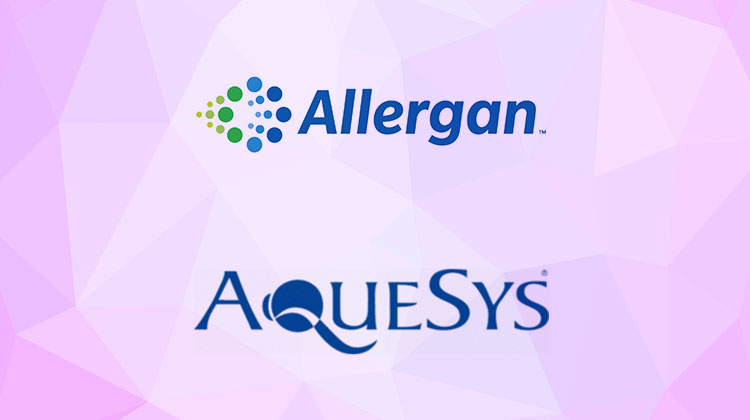Aquesys’ CEO Details Allergan’s Successful Bid

Last week’s sale of Aquesys represented a homecoming for CEO Ron Bache, who started his surgical device career at Allergan in the late 1990s.
However, the decision to sell the privately held MIGS company to the Allergan speaks much more directly to the kind of home Allergan will be for XEN Gel Stent, Aquesys’ entry into the field of Minimally Invasive Glaucoma Surgery.
Allergan won a competitive process by agreeing to pay $300 million up front for the company, which has raised $77 million in venture capital. Allergan committed to paying out more in milestone payments, but CEO Ron Bache declined to say how much those additional payments would total.
Reason suggests they’ll be significant. After all, Glaukos Inc., the current leader in the MIGS space, staged an enormously successful IPO in June. Glaukos, which does have FDA approval for its MIGS device, currently is valued at $1 billion.
Aquesys, meanwhile, has demonstrated exciting data at recent OIS events. However, the company remains a year or so away from securing 510(k) notification for XEN. Meanwhile, the company is selling the device outside the US.
XEN offers a minimally invasive approach to lower intraocular pressure brought on by glaucoma. Currently, IOP is reduced first through medication then invasive procedures including laser trabeculoplasty, and then either a trabeculectomy or a glaucoma drainage device. They work, but they’re invasive and can bring complications.
Aquesys says the acceptable approach to lowering IOP is opening the subconjunctival outflow pathway. Its XEN stent is made of soft, collagen-derived gelatin. Once implanted it creates a outflow of aqueous fluid from the anterior chamber into the subconjunctival space.
In an exclusive Q&A with Eye on Innovation, CEO Ron Bache explains why Allergan beat out “multiple” bidders for the company.
Did you hire a banker to initiate and manage the sale?
We hired bankers only after we had inbound interest. We did not initiate a sale process. But when we had multiple companies involved in the process and I was both running that process and running the company we decided it would be good to have bankers involved. We never made a proactive decision to go sell the company and hire bankers.
Had you considered remaining independent?
Yes. We had a very strong investment syndicate that was very committed to management, and very committed to the technology. We had a lot of dry powder to take us as far as we wanted to go. We had those discussions very late into the entire sales process.
Why now?
We were at a critical juncture. We’re about to go commercial on a global basis if we get approval in the US. So we had to ask, `How do we maximize the potential return for our stakeholders while also maintaining our commitment to patients and doctors. Allergan’s deep resources, and history of successful innovation combined with the deal structure made this the right time.
Glaukos has staged a highly successful IPO. Had you considered following their lead?
We saw the success of the Glaukos IPO and they did a great job with that. So it obviously was another avenue we were considering but decided that the transaction with Allergan would the best outcome for our stakeholders, surgeons, and glaucoma patients.
What made Allergan stand out?
From my perspective, it was a deep commitment to winning through innovation and execution in their key therapeutic areas. Glaucoma is a key area for them, so I know they were going to be dedicated to XEN as well as their overall glaucoma portfolio. Some other companies weren’t as focused on glaucoma as a disease state. They saw XEN more as simply an add on for cataract surgery. XEN can do that as well, but for me Allergan truly understood the value of the glaucoma space as well as XEN’s potential within it. Just talking with them you could tell they instantly “got it.” I also like their leadership. I spent a lot of time talking with them. They understand strategy and how vital it is to execute so I think our cultures will fit nicely. And, this may sound trite, but they always understood the market and the potential for XEN.
I like [Allergan CEO] Brent Saunders and his management style and trusted their very experienced management team. At the end of the day, I am responsible for the team here at Aquesys and the customers and physicians who have trusted us on this journey, so I felt that being a part of Allergan was the best decision we could make.
What is Allergan doing well in Glaucoma?
Allergan has a massive business on the drug side in glaucoma. They are looking to also be the top innovator in this space on the device side so they are able to offer a full portfolio of drugs and treatments for the full spectrum of glaucoma.
Did Allergan acquire earlier-stage glaucoma programs in the deal?
We have other R&D projects that we’re working on that will be part of the new portfolio.
If XEN is approved, will Allergan sell it through a separate sales force?
That is still something we need to decide.
What does the Glaukos IPO and this acquisition mean for MIGS?
The MIGS category or the minimally invasive approach to glaucoma is really in its infancy. We are where the IOL industry was decades ago. Some people were skeptical about using IOLs or phacoemulsification and now it’s the most performed surgical procedure under Medicare.
I think we are going to see the minimally invasive approach when combined with significant efficacy change the way glaucoma is treated for decades. Certainly, a large segment of the glaucoma population will continue to be treated early with medications. However, I think we’ll see glaucoma become much more of a surgically treated disease with the advent of minimally invasive technologies like XEN that also deliver significant efficacy. So you’ll see this as a space really grow.

